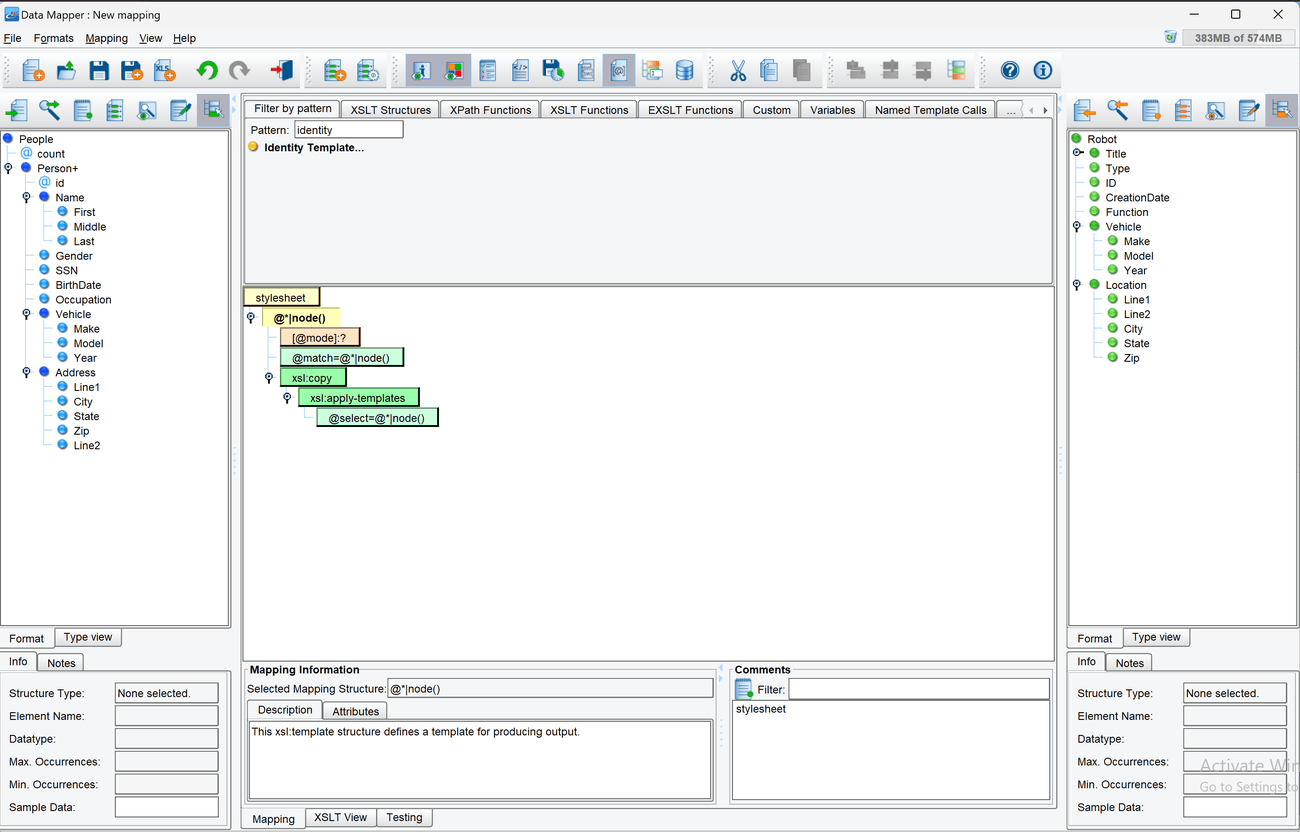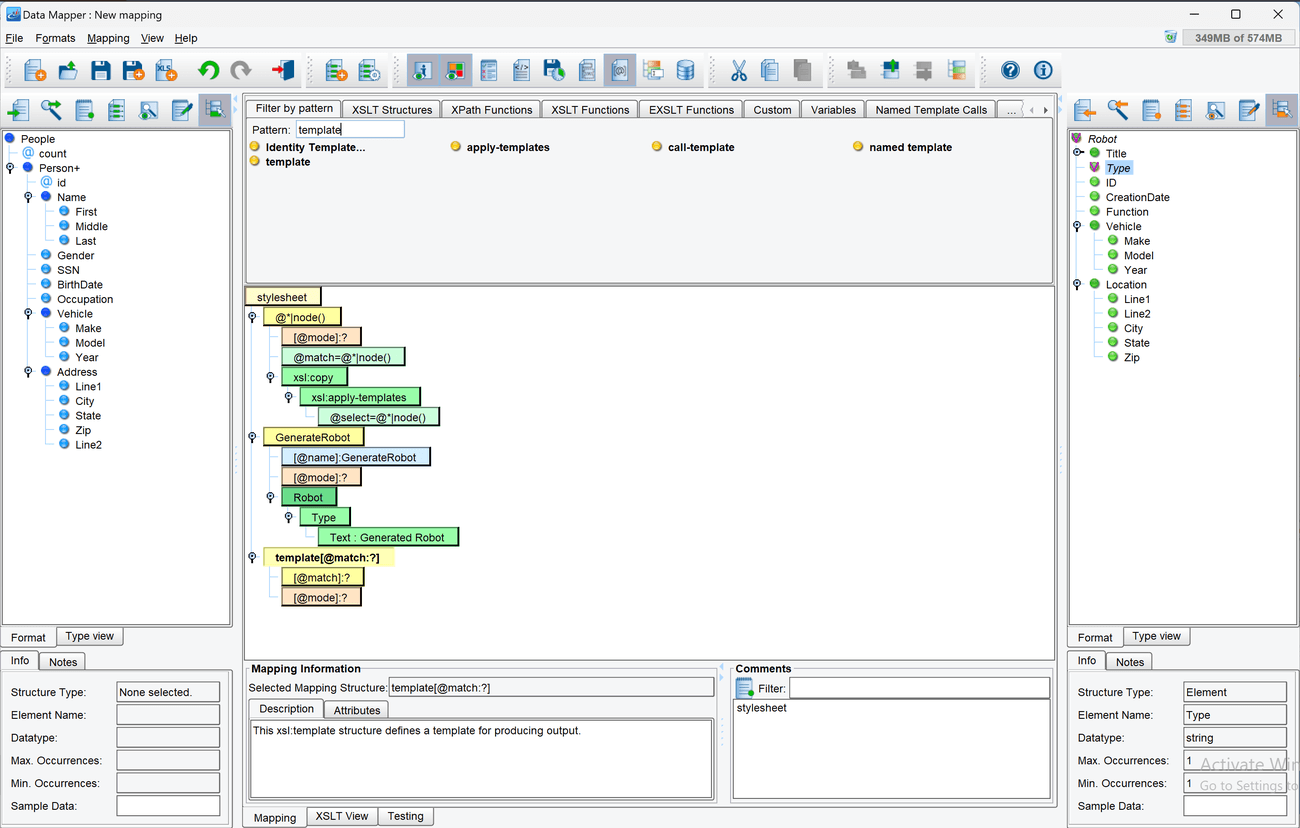Exercise 5.9 – Templates
Purpose:
To practice building an XSLT mapping in the Data Mapper using XSLT templates.
References:
Create a Route
- From the eiConsole File Management screen, select the Add Route button.
- In the dialog that appears, enter the name Templates and select OK.
- The Route should now appear in the table on the screen. Double-click it to open it.
Document Source System
- Select the Source System stage in the Route Editing Grid. The configuration panel will appear at the bottom.
- Change the System Name to People XML File.
- Select the Choose Source Icon button, and scroll down to select one of the XML icons.
Configure the Listener
- Select the Listener stage in the Route Editing Grid. The configuration panel will appear at the bottom.
- Select Directory / File from the Listener Type selection box. Optionally, click the … button to open the Module Search Dialog, which provides a faster way to find the module you’re looking for.
- Assign a polling directory, using the … button to open the file selector. The polling directory should NOT be the directory with all the sample files, since files will be moved/deleted by the listening process.
- Go to the Post-Process tab and select Delete from Postprocess Operation.
Add Source Format and Open Data Mapper
- Select the Source Transform stage in the Route Editing Grid. The configuration panel will appear at the bottom.
- Click the Add Format button. In the dialog that appears, name the Format Templates, and click OK. The transformation configuration panel will appear below.
- On the right-hand side, in the XSLT To XML configuration panel, uncheck the Use Direct Relay button. The options in that panel will now be enabled.
- Click the New button beneath the checkbox to open the Data Mapper.
Load Source and Target Formats
- Use the Open Source Format button above the Source Format panel to open the Select Format dialog. Choose XML from the Format Reader selection box.
- Click the Add button and in the File Selector navigate to where the the sample files are located. Choose the file called people.xml. Click OK, and then click Read Format.
- Use the Open Target Format button above the Target Format panel to re-open the dialog. From the XML Format Reader, re-open the File Selector and select the file called robot.xml (NOT the plural robots.xml). Click OK and then click Read Format.
- The Source and Target Format panels should now be populated.
Add Identity Template
- In the top extension panel, type Identity Template into the Filter by Pattern box. The Identity Template Node should appear.
- Drag the Identity Template node from the top panel onto the center mapping, and drop it onto the Stylesheet node.

Add Named Template
- In the top extension panel, type Named Template into the Filter by Pattern box. The Named Template node should appear.
- Drag the Named Template node from the top panel onto the center mapping, and drop it onto the Stylesheet node. It should appear below the Identity Template in the center panel.

- Double-click on the template[@name:?] node that has just been populated in the center mapping panel. A text field should appear. Type GenerateRobot into it. Press enter to save the changes. The node should now be renamed to say GenerateRobot.
- Drag the root Robot node from the Target format on the right onto the center mapping panel, and drop it onto the GenerateRobot node.

- Drag the Robot node and then the Type node, from the target format on the right onto the center mapping panel, and drop it onto the Robot node.
- Right-click on the Type node in the center mapping panel. Select Add Text Constant from the popup menu. Enter Generated Robot into the dialog box that appears and click OK.

Add Regular Template
- In the top extension panel, type Template into the Filter by Pattern box. The Template node should appear.
- Drag the Template node from the top panel onto the center mapping, and drop it onto the Stylesheet node. It should appear below the Identity Template in the center panel.

- Double-click on the template[@match:?] node that has just been populated in the center mapping panel. A text field should appear. Type /People/Person into it. Press enter to save changes. The node’s name should now have changed to be /People/Person.
![Double click on the template[@match:?] node](data:image/svg+xml,%3Csvg%20xmlns=%22http://www.w3.org/2000/svg%22%20viewBox=%220%200%201300%20827%22%3E%3C/svg%3E)
- In the top extension panel, type Call Template into the Filter by Pattern box. The Call Template node should appear.
- Drag the Call Template node from the top panel onto the center mapping and drop it onto the /People/Person node.
- A dialog box should appear called Choose named template. The GenerateRobot template should be in the list in the dialog. Select it, and click OK.

- The Call Template node should now be on the center panel, below the /People/Person node and it should have the name GenerateRobot on it.

- Now that the mapping is complete, click the Save icon in the toolbar above the tree. When prompted for a name, use the default, transform.
- Click the X button in the top right corner to close the Data Mapper and return to the Route Editing Grid.
Configure the Transport
- Select the Transport stage in the Route Editing Grid. The configuration panel will appear at the bottom.
- Select Directory / File from the Transport Type selection box. Optionally, click the … button to open the Module Search Dialog, which provides a faster way to find the module you’re looking for.
- Select the Target Directory using the … button to open the file selector.
- Set robots-template-output as the Target File Name.
- Set xml as the Target File Extension.
Document the Target System
- Select the Target System stage in the Route Editing Grid. The configuration panel will appear at the bottom.
- Change the System Name to People-Robot XML File.
- Select the Choose Target Icon button, and scroll down to select one of the XML icons.
Prepare to Test
- In the menu bar at the top, select Mode -> Testing Mode. Make sure the changes to the Route are saved.
- Copy the file called people.xml from the Samples directory provided into the directory chosen as the polling directory.
Perform the Test
- At the top of the Testing Mode screen, select the Execute Test button.
- If the Route was configured successfully, all the Stages should light up with green checkmarks.
- In the OS File Explorer, open the directory selected as the Target Directory. The file robots-template-output.xml should be there, with the transformed contents produced by the XSLT.
- The XML file should have a root node called People and a series of Robot Nodes. Each Robot node should have one child node, called Type, that simply says Generated Robot.
Output Files
- Compare the results from the exercise with the following example output files to see if they are correct.





![Double click on the template[@match:?] node](https://cms.pilotfishtechnology.com/wp-content/uploads/2023/11/Add-Regular-Template_002.png)

